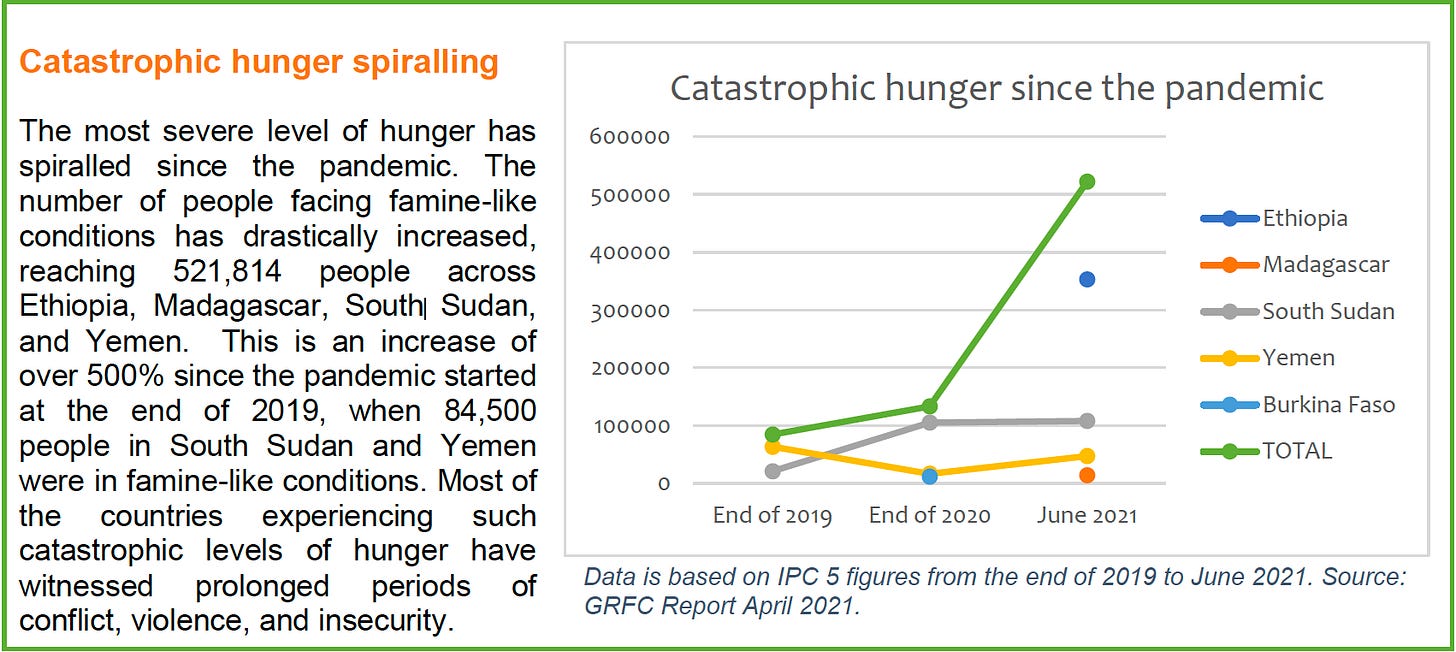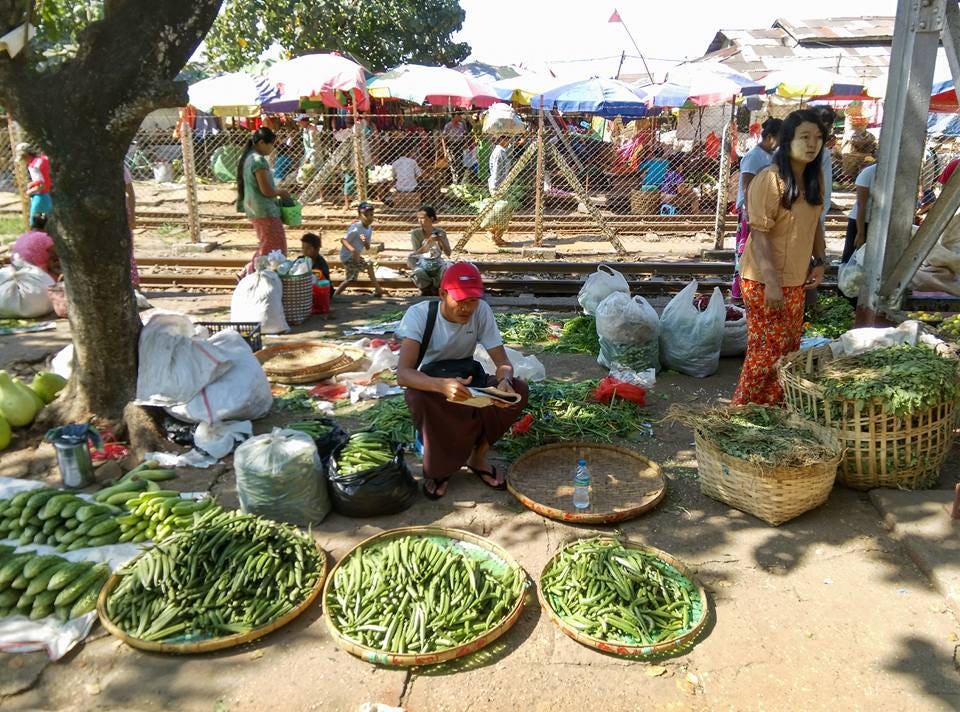The 3Cs of modern hunger - conflict, climate and COVID-19
A newsletter about food systems, climate change and everything connected to them
A word of warning - this week’s newsletter is gonna be pretty grim. Have a glass of wine/tea/kombucha ready.
“For almost three years, we were trapped in our town. We lost our crops and all our savings and had to sell our cattle to survive. How would you feel if all that you can offer to your children is a plate of boiled herbs?” - Leena, Syria.
“As COVID-19 gripped our surroundings in March this year, I was rendered jobless and penniless overnight. Lockdown and related restrictions forced me to discontinue my sewing work or taking up casual labour jobs, bringing our household income to zero.” - Mohammed Iliyas, India
These are excerpts from Oxfam’s latest report called The Hunger Virus Multiplies, a follow up to last year’s report The Hunger Virus, which warned that people going hungry would lead to more deaths than COVID-19 itself.
“Since the pandemic began, the number of people living in famine-like conditions has increased fivefold to more than 520,000,” according to the report. (Emphasis not mine)
It also issued this stark warning - “If no immediate action is taken, 11 people could die every minute by the end of the year from acute hunger linked to three lethal Cs: conflict, COVID-19, and the climate crisis.”
It had more detailed focus on six “hunger hotspots” - Yemen, Syria, Afghanistan, South Sudan, West African Sahel and Venezuela and identified Brazil, India and South Africa as “emerging hunger hotspots”.
The report recommends governments take 7 actions “to save lives now and in the future” -
Fully fund the UN's humanitarian appeal, and support a global fund for social protection
Guarantee humanitarian access in conflict zones and an end to using hunger as weapon of war
Forge peace by promoting women’s participation and leadership in peacebuilding
Build fairer, more resilient, and more sustainable food systems,
Ensure women lead the pandemic response and the recovery
Support a People’s Vaccine
Take urgent action to tackle the climate crisis
The UN annual hunger report is coming out on Monday too and I think is safe to assume it will also find global hunger has worsened over the past year.
The Oxfam report also said -
Conflict was the single largest driver of hunger since the pandemic began. For example, Afghanistan, the Democratic Republic of Congo, Syria, and Yemen – some of the world’s worst hunger hotspots - are all torn by conflict.
COVID-19 devastated many economies, leading 33 million workers worldwide to lose their jobs. 2.7 billion people have not received any public financial support to deal with the pandemic’s economic devastation.
Nearly 400 weather related disasters, including record-breaking storms and flooding, battered millions across Central America, Southeast Asia, and the Horn of Africa in addition to conflict and COVID-19-related poverty.
Agriculture and food production bore 63% of the impact of these shocks, and of course it is the poor countries and communities who lost the most.
Commodity prices have shot up but that hasn’t translated into more money for food producers, especially small-scale farmers because they could not afford to buy seeds and fertilizers or transport their produce to markets.
Vaccine inequality threatens to worsen these numbers even further. Oxfam said its own calculations showed that at the current vaccination rate, low-income countries would be waiting 57 years to fully vaccinate their populations.
The virus threatens to cause a further 132 million people to be undernourished due to lost jobs, disrupted incomes and poor health, it added.
Still, global military spending rose by 2.7% last year. This amounted to $51 billion, enough to cover the $7.9 billion 2021 UN humanitarian food security appeal six and a half times over.
Let’s add another ‘C’ - coup
News from my home country isn’t much better either. A latest assessment by the International Food Policy Research Institute (IFPRI), based on multiple rounds of surveys and data collection done over the past year, including respondents from nearly half of Myanmar’s 356 townships.
“Because of the compounded effects of the COVID-19 pandemic and the political disruption in the country, the suffering this year will be more profound; simulations show that between 40 and 50% of the population in Myanmar will be in poverty under the modest and large economic effect assumptions,” it said.
“The poverty and food insecurity situation in Myanmar is dire and there is an urgent need to deliver humanitarian assistance,” the paper said. This is particularly important as the “lean season”, when people are usually short of both food and money, is imminent.
Help should focus on “in-kind food assistance” because of problems accessing cash through the banking system, it added.
What else?
Between 44% and 54% of individuals are predicted to live in households that are unable to afford a recommended diet today, compared to 36% in 2015.
60% of predicted newly poor households are in the Delta and Dry Zone, 25% in the Hills and Coastal zones, and 15% are in Yangon.
However, current UN humanitarian response plans focused on pre-coup conflict areas and they don’t include the Delta and Dry Zone, which account for more than 80% of Myanmar’s cropped area.
Overall, 3 out of 4 newly poor households are in rural areas. These estimates do not reflect recent migration out of Yangon to rural areas.
Impact on agriculture sector
“The timing of the military take-over could not have been worse from the point of view of the agricultural sector, occurring just as the rural economy was beginning to recover from COVID-19, in part due to the recent earnings from the monsoon harvest and in part due to the resumption of remittance flows from migrant household members..”
“Five months after the coup, as farmers undertake land preparation and planting for the 2021 monsoon season, they are confronted with steep increases in fertilizer and fuel prices while access to credit for farm operations is severely limited.”
All of this means the sector is likely to contract.
Helpful reminder - production of crops, livestock and fisheries contributed 23% of GDP, related services such as input supply, processing, distribution increase the share of GDP to 34%. Performance of this sector “directly affects employment and incomes for more than 80% of the rural population”.
To me, the most heartbreaking bit is this: “Prior to the February 1 military intervention, Myanmar’s economy was on a recovery track, albeit a slow one.”
Let’s get flexible
An interesting study by researchers from U.S., UK and Canada shows how to get people to eat less meat. You might think it’s a no-brainer but I found it an interesting behavioural science research.
Essentially, they got people to share their baseline meat consumption, attitudes and beliefs through an online survey, then gave them “treatment” - an op-ed that appeals people to reduce meat consumption, an op-ed that appeals people to eliminate meat consumption, or a “control” op-ed that is not related to meat consumption at all.
The text of the op-eds was nearly identical, talking about health, environment and animal welfare benefits to eating less meat, except that for the “reduce” op-ed, it was all about reducing, and for the “eliminate” op-ed, well, you get the idea.
Both appeals were “initially able to shift intentions to eat less meat” but only the “reduce” one actually affected consumption, with 7% to 9% less consumption of meat, and this held for the 5-month duration of the study, the researchers said.
This is also “the first experimental results to our knowledge that assess persistent effects of a mass communication messaging anti-meat appeal over time”, they added.
The study was done in four waves, with 1,650 participants, half as much as the initial number of participants.
They then tried a second experiment where they tried to see whether the same results would apply for a nationally representative sample. Neither appeal had any effect on meat consumption.
But what it did find was there were effects for “younger, liberal, more educated and less wealthy participants”.
Of course, giving up meat entirely is much much harder than simply reducing it but I found the researchers’ point on thinking of and framing meat consumption in either a categorical way (yes versus no) or continuum (meals per week) particularly illuminating.
“Just thinking about meat consumption in categorical terms reduces people's willingness to consider eating less meat,” they said. In other words, categorical appeals for change, not just in terms of meat, are likely to be seen as “too large of a request or departure from one's identity”.
As always, have a great weekend! Please feel free to share this post and send tips and thoughts on twitter @thinink, to my LinkedIn page or via e-mail thin@thin-ink.net.








